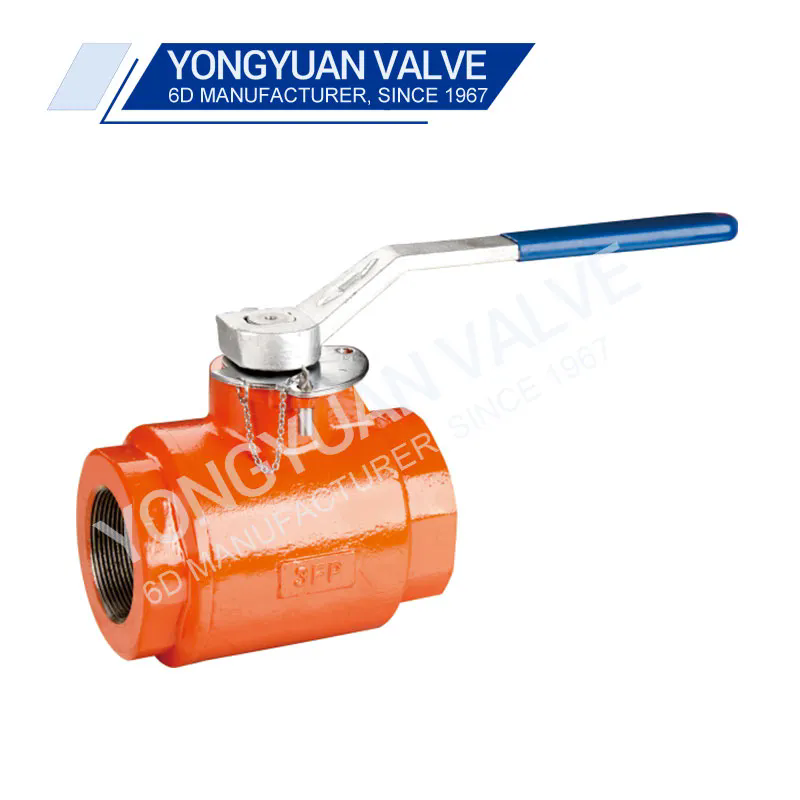Oilfield Threaded Ball Valve: A Comprehensive Q&A Guide
2024-10-23
Ball valves are essential components in oilfield operations, providing a reliable means of controlling the flow of fluids. Among the various types of ball valves, threaded ball valves stand out for their versatility and ease of installation. This blog aims to answer common questions about oilfield threaded ball valves, their functionality, applications, and maintenance.
What is an Oilfield Threaded Ball Valve?
An oilfield threaded ball valve is a type of valve that uses a spherical disc, or ball, to control fluid flow through a pipeline. The valve features threaded connections that allow it to be easily installed or removed from piping systems. When the valve is opened, the ball rotates to align the flow path with the pipe; when closed, it blocks the flow completely.
How Does a Threaded Ball Valve Work?
Threaded ball valves operate based on a simple mechanism. The valve consists of a hollow, perforated ball that is pivoted in the center of the valve body. When the valve handle is turned, the ball rotates either to allow fluid to flow through or to block it. The tight seal created by the ball against the valve seat ensures minimal leakage, making these valves highly efficient for fluid control.
What Are the Advantages of Using Threaded Ball Valves in Oilfields?
There are several advantages to using threaded ball valves in oilfield applications:
Easy Installation: The threaded connections simplify the installation and removal process, saving time and labor costs.
Reliable Performance: Ball valves provide a tight seal, reducing the risk of leaks and ensuring safe operation under high pressure.
Durability: Made from robust materials, threaded ball valves can withstand harsh environmental conditions typical in oilfields.
Versatility: These valves can handle various types of fluids, including oil, gas, and water, making them suitable for multiple applications.
What Materials Are Used to Manufacture Threaded Ball Valves?
Threaded ball valves are typically constructed from durable materials designed to withstand the corrosive nature of oilfield fluids. Common materials include:
Carbon Steel: Used for its strength and resistance to pressure.
Stainless Steel: Offers excellent corrosion resistance, ideal for harsh environments.
Brass: Sometimes used for smaller valves in less corrosive applications.
Plastic: In some cases, thermoplastics are used for specific chemical resistance.
What Applications Are Threaded Ball Valves Used For in Oilfields?
Threaded ball valves are used in various applications within oilfields, including:
Fluid Control: Regulating the flow of crude oil, natural gas, and other fluids in pipelines.
Production Equipment: Used in wellhead assemblies, separators, and other production equipment to manage flow and pressure.
Injection Systems: Controlling the injection of water, chemicals, or gas in enhanced oil recovery processes.
Safety Systems: Providing emergency shut-off capabilities in case of leaks or equipment failures.
How Do You Select the Right Threaded Ball Valve for Your Application?
When selecting a threaded ball valve, consider the following factors:
Pressure and Temperature Ratings: Ensure the valve can handle the specific pressure and temperature conditions of your application.
Size and Connection Type: Choose the appropriate size and thread type that matches your piping system.
Material Compatibility: Select a valve made from materials compatible with the fluids being transported to prevent corrosion or damage.
Actuation Method: Consider whether you need manual operation or a more automated solution, such as an electric or pneumatic actuator.
What Maintenance Is Required for Threaded Ball Valves?
Regular maintenance is essential to ensure the longevity and performance of threaded ball valves. Recommended maintenance practices include:
Inspection: Regularly check for leaks, corrosion, or other signs of wear.
Cleaning: Keep the valve exterior clean and free of debris to prevent operational issues.
Lubrication: Lubricate the valve stem and handle to ensure smooth operation.
Testing: Periodically test the valve’s functionality by opening and closing it to confirm proper operation.
Are There Any Limitations to Using Threaded Ball Valves?
While threaded ball valves have many benefits, there are limitations to consider:
Size Restrictions: Threaded connections may not be suitable for larger valve sizes, where flanged or welded connections are often preferred.
Potential for Leakage: Over time, the threaded joints may loosen, leading to potential leaks if not properly maintained.
Pressure Limitations: Some threaded ball valves may have lower pressure ratings compared to other valve types, which may not be suitable for all applications.
How Do Threaded Ball Valves Compare to Other Types of Ball Valves?
Threaded ball valves differ from other ball valve types primarily in their connection method. Unlike flanged or welded ball valves, which may provide a more secure connection for high-pressure applications, threaded ball valves offer ease of installation and removal. They are suitable for smaller, less demanding applications, while other types may be better for larger systems requiring higher pressure ratings.
What Is the Future of Threaded Ball Valves in the Oilfield Industry?
The future of threaded ball valves in the oilfield industry looks promising, driven by advancements in materials and manufacturing processes. With a growing emphasis on safety, efficiency, and environmental protection, the demand for reliable and durable fluid control solutions will continue to rise. Innovations in valve design, such as improved sealing technologies and automation capabilities, will likely enhance the performance and reliability of threaded ball valves in various applications.
Conclusion
Oilfield threaded ball valves are vital components that ensure the safe and efficient control of fluid flow in various applications. Understanding their features, advantages, and maintenance requirements is essential for optimizing their performance. As the oilfield industry evolves, threaded ball valves will remain a key technology for managing the complexities of fluid transport and control.



